| Pages:
1
2 |
agent_entropy
Hazard to Self
 
Posts: 91
Registered: 17-7-2006
Location: U.S.
Member Is Offline
Mood: No Mood
|
|
Now that I have finished, I thought I would share my whole experience with isolating I2.
A few months ago when I was cleaning out a laboratory I found 2 bottles of KI solution that had expired a LONG time ago and were VERY yellow in color.
Check out the expiration dates.
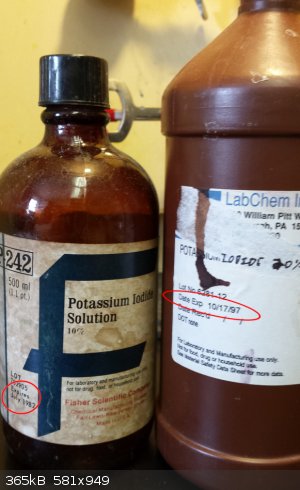
I decided to precipitate the iodine by adding nitric acid as I have a ready supply and it would not form any insoluble salts with potential impurities
(also it acts as both the acid and the oxidizer). After rinsing with DI water, a cake of very small, very wet I2 crystals was left.
The iodine was then dried by fusion under concentrated sulfuric acid to yield a solid lump (as described by others above). However, this lump had
channels and pockets full of sulfuric acid inside it.
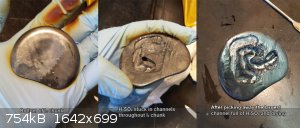
I did my best to get the majority of the acid out by picking away at the channels and rinsing out the acid, but when I broke the chunk in half I found
a bunch of acid pockets still inside.
I crushed the chunk into granules and blotted them as dry as possible. Then melted the chunk into liquid without the sulfuric acid blanket and poured
the iodine into a cool shallow pan. This seemed to exclude the remaining sulfuric from the bulk iodine film. I then scraped the film out of the dish
and proceeded to sublimate it.
At first I tried a makeshift sublimator, as described in a previous post, but this produced very small needle-like crystals with high surface area and
high susceptibility to static electric charge. This made them very difficult to handle and was unsatisfying.
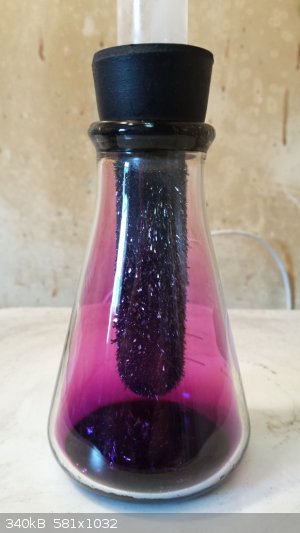
I now know that if you want to isolate iodine as high-quality, large-granule, easy to handle crystals AND you want to incur as little loss as
possible, then the name of the game is low heat and PATIENCE.
I placed the iodine in a jar and sat it on the top of a laboratory oven near the vent.
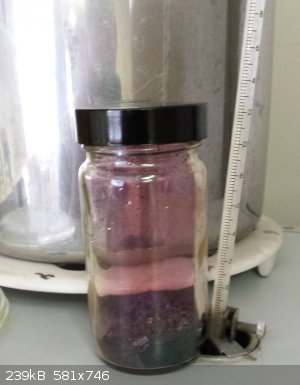
As crystals collected on the slightly cooler upper surfaces within the jar I scraped them away and collected them. After about a month of doing this
I collected the last of the iodine crystals.
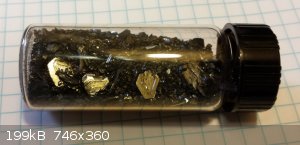
I also collected a small amount of brown powdery material from the bottom of the sublimation jar consisting of the impurities that the sublimation
process removed. I think it’s probably either a sulfate or some organic contaminants from blotting away the sulfuric acid.
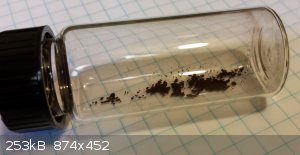
A final piece of advice: Use plastic tools to scrape the iodine or handle it in any way, because, as I discovered, iodine attacks stainless steel. In
the picture you can see how the iodine has damaged the finish and whatever iodide salts formed by reaction with the stainless are absorbing moisture
from the atmosphere and becoming liquid (thus, the smeared appearance). http://cdn.intechopen.com/pdfs-wm/46242.pdf
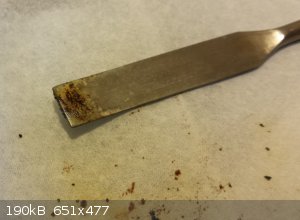
|
|
|
agent_entropy
Hazard to Self
 
Posts: 91
Registered: 17-7-2006
Location: U.S.
Member Is Offline
Mood: No Mood
|
|
Neptunium's comment about drying a solution of I2 in DCM over sulfuric acid and letting the DCM evaporate got me thinking about other solvents that I2
might be soluble in. So I tried dissolving I2 in liquid butane. It didn't dissolve very well since the butane was very cold as it was boiling away.
This made me want to produce a saturated solution of iodine in butane (actually isobutane, from a lighter refill). I managed to make a saturated room
temperature solution of I2 in liquid butane under pressure inside a small soda bottle. The solution is definitely saturated because there are a few
small crystals of I2 in the bottom that will not dissolve.
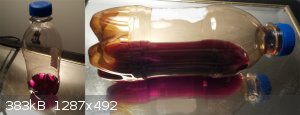
After storing the solution for about a week the bottle was looking pretty rough.
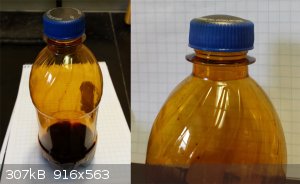
So I did some experiments with the solution... First, some of the solution was poured onto a watch glass to see what would happen. Predictably, the
butane started boiling away and small I2 crystals began forming and depositing on the glass. The watchglass was left until any material that could
boil away or sublimate was gone. What was left was a very small amount of brownish residue, likely iodinated products of impurities in the butane.

Since halogens tend to inhibit fire, a small sample was ingnited on a watchglass. As is clear from the picture, not enough I2 vapor was rising to
inhibit combustion. After the butane had burned away, I2 crystals remained on the glass.
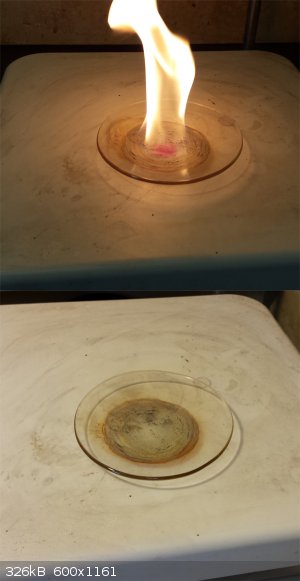
The rest of the solution was allowed to evaporate in a flask.
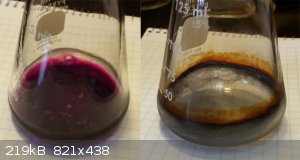
I wonder what other solvents with a boiling point below room temperature might be interesting or useful for dissolving iodine. Certain freons?
Carbon dioxide? Even though liquid nitrogen is non-polar I suspect that it would be too cold to dissolve any appreciable amount of iodine, and I
don't know of any way to keep it liquid at room temperature since the pressure would be insanely high.
|
|
|
AJKOER
Radically Dubious
    
Posts: 3026
Registered: 7-5-2011
Member Is Offline
Mood: No Mood
|
|
Would simply treating a thin layer of moist iodine in a vessel with frigid air and stirring periodically, effectively dry the iodine? Note, the iodine
is in a container to capture any sublimated I2 as per Wikipedia http://en.m.wikipedia.org/wiki/Portable_water_purification, to quote:
"Iodine crystals will sublimate if exposed to air for long periods of time".
If feasible, one could avoid adding organic contaminants (or, for that matter, other drying agents).
My logic is that the reaction of I2 and water, namely:
I2 + H2O = HI + HIO
is moved more to the left for neutral water (and more so, by adding, say CO2) as the temperature is lowered forming solid ice, which hopefully
sublimes and is successfully removed from the vessel in the blast of cold dry air. To quote from a reference ( https://www.google.com/url?sa=t&source=web&rct=j&... ):
"The air is so dry that when it hits a snowpack, the frozen water evaporates, going directly from the ice to vapor and bypassing the liquid phase
entirely. This is called sublimation, and it's a common way for snow to disappear in the arid West."
Note, if one instead opts for heating, would not more moist iodine be lost in the form of HI and HIO3 ?(the latter from the disproportionation of 3
HIO to HIO3 + 2 HI and possible subsequent reaction with 2 more HIO resulting in HIO3 + 2 I2 + 2 H2O from 5 HIO). However, I should add that the
iodine sublimation process (which occurs at about 180 C) itself can result in a high purity product, although thermal decomposition of HIO3/I2O5 at
higher temperatures (over 300C ) can produce some iodine oxides as well (see https://docs.google.com/viewer?url=patentimages.storage.goog... ).
Interestingly, my curious suggestion is a complete turn around from the normal suggestion of employing warm iodine sublimation with the primary focus
on the sublimation of the ice instead!
The good news is that if this methods does not work, little product is lost and, upon warming to RT, you are where you started, the same purity moist
iodine.
Unfortunately, I do not have sufficient iodine on hand to test my curious hypothesis. In any event, I would not argue that the proposed process is the
most economical, rapid, highest purity or scalable, but does obviate the need for other reagents.
[Edited on 8-6-2015 by AJKOER]
|
|
|
agent_entropy
Hazard to Self
 
Posts: 91
Registered: 17-7-2006
Location: U.S.
Member Is Offline
Mood: No Mood
|
|
An interesting reversal of the paradigm, AJKOER. Sounds like freeze drying (lyophilization) could work, provided that the water is more volatile than
the iodine under whatever conditions are employed.
All of the freeze drying I have done in the past involved freezing with liquid nitrogen followed by gentle warming (<60 C) under vacuum, but I like
the idea of a dried gas stream to drive the sublimation of water. Such a stream could remove the need for heating and vacuum if it is sufficiently
dry to avoid depositing more moisture by condensation on the chilled sample.
|
|
|
Molecular Manipulations
Hazard to Others
  
Posts: 447
Registered: 17-12-2014
Location: The Garden of Eden
Member Is Offline
Mood: High on forbidden fruit
|
|
Nitrogen has a critical temperature of -147 degree's C, no amount of pressure will mantain it as a liquid above that temp.
Sublimating iodine using boiling water as a heat source is how I purify it - never had a problem before.
-The manipulator
We are all here on earth to help others; what on earth the others are here for I don't know. -W. H. Auden
|
|
|
confused
Hazard to Others
  
Posts: 244
Registered: 17-3-2013
Location: Singapore
Member Is Offline
Mood: tired
|
|
Quote: Originally posted by MrHomeScientist  | | I tried to sublime iodine once but kept getting water condensation on my cold flask that kept everything wet. Does this get eliminated with the
sulfuric acid drying step? My iodine wasn't damp at all, but I do live in a humid climate. |
Same thing happened to me, when i tried that, does sulfuric acid prevent that from happening?
|
|
|
agent_entropy
Hazard to Self
 
Posts: 91
Registered: 17-7-2006
Location: U.S.
Member Is Offline
Mood: No Mood
|
|
@Molecular Manipulations: Right! I forgot about the critical point. Silly me!
@confused: Sulfuric acid drying will probably not prevent the water condensation, the water is probably condensing from the atmosphere. You can try
to prevent it by doing the sublimation on a cool, dry day (low humidity), or by doing the sublimation under vacuum, or by sublimating at low temp
inside a sealed jar.
|
|
|
| Pages:
1
2 |